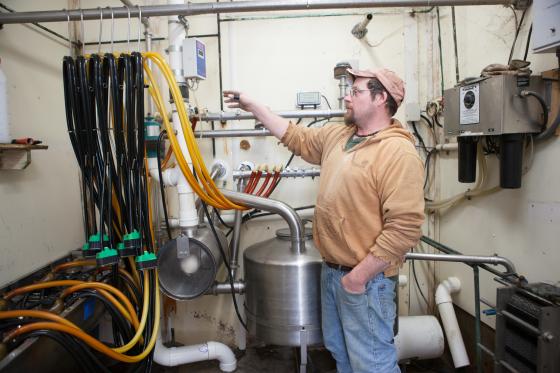Posted March 17, 2022 at 10:36am by Anonymous (not verified)
Efficiency on a Dairy Farm

Prepared by JJ Vandette, Planning and Development Associate, Efficiency Vermont
Highlights: $7,600 in first year savings ● $94,000 in lifetime savings ● 58,300 kWh in annual electricity savings ● Close relationship with the equipment vendor and Efficiency Vermont led to major cost savings and business improvements
Brace Farm Inc. is a small dairy that has been owned and operated by the Brace family since 1984. The current owners, Alex and Michelle Brace, took over operations from Alex's father in 2006. Brace Farm consists of two main buildings, including a tie stall barn where the cows are milked and a separate free stall barn that houses the dry cows. Twice per day, 140 head of Holsteins are milked, and over four million pounds of milk per year are shipped via the St. Albans Cooperative Creamery.
Collecting, cooling, and shipping this volume of milk is an energy-intensive process, and keeping the barns lit and properly-ventilated also adds to the energy requirements of the farm. However, Alex Brace has taken significant steps to manage his energy use and to use energy more efficiently, all while maintaining milk production and preserving the longevity of his equipment.
Plate Cooler Saves Energy by Precooling Milk
One of the first energy efficiency projects that Alex implemented was the installation of a plate cooler, which is a heat exchanger that uses water to precool milk, reducing the energy required by the refrigeration system to cool the milk in the bulk tank. This project, as with many others involving his milking equipment, was a collaborative effort between Alex and his equipment vendor, Todd Reed of Reed’s Equipment (Vergennes). Todd helped size the plate cooler properly and worked with Efficiency Vermont, which helped cover a portion of the equipment costs. By installing this plate cooler, the Brace Farm is now saving 13,811 kWh annually, which amounts to approximately $1,750 per year.
Heat Recovery Unit Saves Energy by Capturing Waste Heat
Every dairy farmer knows that proper sanitation and high milk quality go hand-in-hand. In order to ensure that his milking equipment is sanitized properly, Alex has to have a constant supply of hot water. To reduce the energy required to heat his 120 gallon hot water tank, Alex purchased a new heat recovery unit. This unit captures the waste heat from his bulk tank compressor to pre-heat the water so that the hot water heater doesn’t have to work as hard. Alex replaced his old tank (which had sprung a leak), and Efficiency Vermont helped subsidize the cost with a $1,000 rebate on the cost of the equipment. “This equipment is a no-brainer,” says Alex, “and it’s very cost-effective.”
Energy Efficient Exhaust Fan Improves Ventilation
To ensure his cows were comfortable and the air in the barn was being exchanged properly, Alex determined that one section of his barn needed to exhaust more air. He purchased an energy efficient exhaust fan for the tie stall barn, and Efficiency Vermont was able to provide some financial assistance to purchase a more efficient fan model. With his barn properly ventilated, his herd is exposed to less heat stress, which keeps his milk production more stable through the summer months.
Variable Frequency Drive Decreases Electricity Use
More recently, Reed’s Equipment helped install a variable frequency drive (VFD) on the milk pump at Brace Farm, which allows the pump to run at different speeds depending on actual need. When not running at full capacity, less electricity is used. Efficiency Vermont helped subsidize the cost of this installation, as well. This new VFD holds the vacuum level better, which allows for milking times to be faster—and is better for the cows, too.
Durable Vapor-Proof Lighting Provides Even Light Distribution
Alex also took advantage of the rebates that Efficiency Vermont offers for agricultural lighting. He installed energy efficient vapor-proof lighting that was both more efficient than his old lighting and provided better light distribution. “The light output is great,” says Alex. He also changed out the older, less-efficient lighting in his shop.
Looking to the Future
Alex and Reed’s Equipment are discussing the installation of a variable speed milk transfer unit, which will slow the flow of milk through the plate cooler in order to maximize the heat exchange and will further reduce the burden on the compressors cooling the bulk tank.
Learn more about energy efficiency and renewable energy in the Energy section.
